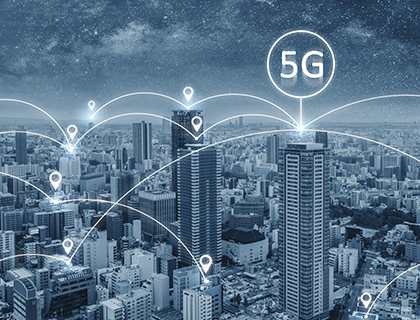Get the latest digest on business and technology trends straight to your inbox.
80% of enterprises in APAC believe that 5G will form the core of their business processes. However, many are having troubles with choosing the right 5G use cases for their business. Here's how you can overcome implementation barriers to kickstart your 5G journey.

The Asia Pacific is leading the world in embracing 5G, with the COVID-19 pandemic accelerating interest in the technology. According to a Datacenter News report, enterprises have been signalling greater interest in 5G and the Internet of Things (IoT) since the start of the outbreak last year.
5G is viewed as a critical enabler for businesses to realise the potential of disruptive technologies such as AI and IoT, enabling them to establish their leadership in the market. However, many organisations are still approaching deployment with caution, with just 17% of enterprises currently investing in 5G1.
The gap between enthusiasm and actual adoption suggests that there are still many business barriers to 5G implementation. A Deloitte study on advanced wireless adoption during the pandemic found that many businesses are unsure of the business value of advanced networking or have difficulty identifying the right use cases to target2.
Starting 5G on the right note will involve working with the right service provider and a 5G ecosystem that will not only provide connectivity, but can also help businesses to embark on commercial trials, develop end-to-end solutions and deliver business outcomes as opposed to pure technology benefits.
For starters, many business leaders do not really understand how to make 5G work for them. 5G holds out the promise of being a catalyst for transformation. It presents an opportunity for businesses to innovate, overhaul their operations and diversify their business models. But the proof of the pudding is in the eating.
To prove that the technology can deliver for the different possible use cases, businesses need to invest time to conduct early trials and validation testing, leveraging the expertise of its service provider and the technologies and product offerings available through the 5G ecosystem. This will give them the opportunity to fully explore the technology and develop robust use cases to support the rollout of 5G.
The service provider can also help the business to address other barriers to 5G adoption, such as the shortage of relevant skillsets within the organisation.
Many businesses face a talent and skills shortage when it comes to trialling 5G, not to mention a full-fledged rollout of the technology. The difficulty lies in the fact that 5G will require skillsets that cut across traditionally siloed areas such as platforms, connectivity, performance, analytics and insights, and user experience3.
Think about the prospect of having to build or hire resources that understand radio frequency and spectrum, have knowledge of software-defined networks and network protocols, and can programme in languages like Python, Scala, Julia and R, and the problem becomes obvious.
Instead of the traditional focus on underlying technology skill sets, businesses will need to adopt a functional approach based on what they are trying to accomplish, and work with a partner that is able to plug the gaps in their existing teams.
Another barrier to 5G is the complexity that the technology is expected to add to the operating environment. 5G networks are expected to become more virtualised, open and programmable, all of which will contribute to the complexity of operating environment.
The service provider plays an important role as an orchestrator that assembles the pieces needed by the business, customising and optimising solutions based on business requirements and allowing new and innovative services to be added to the network.
With 5G enabling a hyperconnected world, there are also concerns over security across the network, infrastructure and user environments. For example, the exponential growth in the number of devices that can now be connected to the network increases the potential network entry points and the risk of data breaches. It also presents challenges in ensuring secure service access and supply chain integrity.
This means that with 5G, businesses will have to redefine many of their policies and procedures relating to security. On the technical front, the service provider can help the business fully utilise 5G capabilities to enhance security. An example is network slicing, which allows unique security policies to be set and enforced for isolated slices of the network. With the right expertise, the service provider can help ensure that the slices are configured and managed properly.
Another advantage that a service provider brings to the table is the network of industry players, application developers and solution providers that it works with, to focus 5G efforts around a particular sector or 5G use case. This will help ensure that the 5G products, services and solutions provided by the ecosystem are aligned with the needs of the particular industry.
Many businesses acknowledge that they need help to imagine the future possibilities for connected solutions with 5G, and will look outside their own business to unlock 5G’s potential4. Working with the right partner and plugging into an effective and vibrant 5G ecosystem will enable them to overcome barriers to 5G and focus on the pursuit of their transformation and innovation goals.
Speak to us to overcome the barriers of 5G implementation.
1Datacenter News, COVID accelerates interest in 5G, digital transformation and IoT, 2021.
2Deloitte Insights, Accelerating enterprise innovation and transformation with 5G and Wi-Fi 6, 2021.
3TekSystems, How to field the right workforce for the 5G revolution, 2019.
4ComputerWeekly, Security fears persist but businesses overwhelmingly see positive impact of 5G, 2020.
Get the latest digest on business and technology trends straight to your inbox.
Get the latest digest on business and technology trends straight to your inbox.
